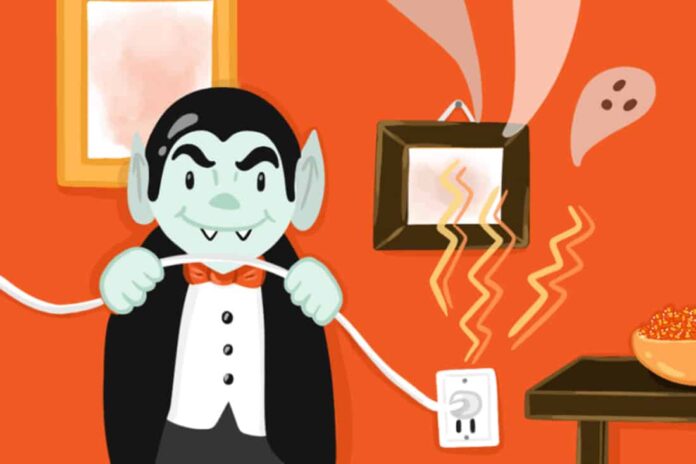UNTIL RECENTLY, I thought vampires—creatures of the night that suck the life from their victims—existed only in the fictional realms of literature and TV. That’s until I learned about a real-life scenario draining both our wallets and the planet: vampire energy. [Source: Wired ]
Vampire energy, also called standby power or phantom loads, is power certain electronics and electrical appliances consume even after they are placed in standby mode or switched off. Devices without clocks and dashboards, such as lamps and toasters, do not consume vampire energy. But many “smart” products do; for these devices, energy use comes mainly from adaptors converting AC into DC and circuits that continue to be energized even when a device is “off.”
We also have an abundance of appliances with internal thermostats working around the clock to maintain specific temperatures. Water coolers are one of the biggest culprits. In the past, we’d grab a glass of water from the faucet and throw in some ice. Today, the water cooler is always running (and the water cooler market in the United States has swelled to nearly a billion dollars). These appliances are frequently set at around +3.1°C/37.6℉ for cold and +94°C/201.2℉ for hot water. Both ends of the spectrum require a significant amount of energy.
Although estimates vary, vampire energy consumption can account for as much as 40 percent of a building’s energy use and associated monthly electricity bill. These figures seemed staggering to me, so I conducted a test. Because it’s not enough to turn things off, I went around and unplugged everything in my house that is not in regular use, including electric heaters, multiple candle warmers, and several abandoned surge protectors and charge stations, among various other household appliances.
My electricity bill dropped by $38 the next month and $30 the month after, shaving about a third off what I typically paid. While that is impressive, my tiny home is just a blip on the map. Studies from the Natural Resources Defense Council (NRDC) have found that more than 100 billion kilowatt-hours are wasted every year because of vampire energy, “costing American consumers over $19 billion—about $165 per US household on average—and 50 large (500-megawatt) power plants’ worth of electricity.”
BUT VAMPIRE ENERGY is not just a money suck; it’s killing our planet. Electricity is often generated through the combustion of hydrocarbons like oil, gas, and coal, which release significant amounts of carbon dioxide. According to a study conducted by Earthday, 100 billion kilowatt-hours of vampire energy produce nearly 80 million tons of carbon dioxide, the equivalent of the annual carbon emissions from about 15 million cars. This accounts for around 1 percent of the world’s total carbon emissions.
And while residential waste plays a role, industrial vampire energy consumption is a much bigger contributor to those emissions. In addition to industry-specific appliances, industrial vampire energy culprits include the vending machines, water coolers, and photocopiers lurking around every corner in commercial buildings, warehouses, and other facilities. We don’t really know how often people use these machines, but they still consume energy 24/7. They also take up space that is needed for proper ventilation of a building; buildings are more energy-efficient when they have less stuff in them.
Priya Vijayakumar, CEO of WattIQ and an expert in unmanaged energy, explains that at the industrial level, 21 percent of all electricity consumed by buildings is wasted. “There’s all this unmanaged electricity. On top of that, there are 40 percent more electrical devices than needed. Just think about all the energy it takes to manufacture and transport these products,” she says.
Today, life sciences companies—on track to surpass $2 trillion in gross value by 2023—are one of the world’s largest consumers and polluters. Unsustainability begins in the drug development stage and continues into the manufacturing process, where laboratories consume 5 to 10 times more energy per square foot than office buildings do.
This is largely due to laboratory refrigerators and freezers, which are massive and draw substantial amounts of vampire energy as they run nonstop to maintain +4℃/39.2℉ for the refrigeration of pharmaceuticals and supplies and ultra-low temps of around -80℃/-112℉ for long-term storage and stability. Over the course of a day, an average ultra-low temperature freezer typically consumes as much energy as an entire home. The freezers are necessary for research, of course, but Vijayakumar says they are not always properly maintained, causing them to use 30 to 40 percent more energy than they need.
And life sciences is only one of countless industries where vampire energy has spiraled out of control due to overconsumption and mismanagement of kilowatt-hours. So, what can be done?
To date, energy-efficiency laws passed by Congress focus largely on residential energy use. Under these laws, the Department of Energy (DOE) is authorized to establish standards for 19 consumer products but only 11 types of industrial equipment. There are many pieces of industrial equipment and devices missing from the list. “In part because of this fact, it may not always be easy to identify products with low standby energy consumption [on the industrial level],” says Joe Vukovich, an energy efficiency advocate at the NRDC. “If standby energy isn’t captured by DOE standards, there simply may not be any information available for purchasers to base a decision on. Congress could strengthen the ability of the DOE to tackle this when it comes to commercial or industrial products.”
Vijayakumar agrees that regulation is needed but further emphasizes the role of manufacturers, using infusion pumps as an example. Hospitals frequently replace these pumps—used to deliver fluids to a patient’s body in controlled amounts—because their software becomes obsolete. Vijayakumar would like to see a “product-as-a-service” model in which the manufacturer is responsible for the life cycle of a product, and the end user essentially buys the service of that product—similar to a traditional leasing model for baseline usage. With infusion pumps, software updates would be provided, extending the life of the equipment and ensuring it runs optimally (under service contracts) to reduce energy consumption. Under this model, manufacturers might adopt a different mentality when designing products—focusing on delivering value, including energy efficiency, rather than on the number of units sold—and products wouldn’t become obsolete as quickly.
Though it would be ideal for DOE standards to reign in vampire energy, we now have the technology to collect data on how much energy we are wasting. Historically, this data hasn’t been readily available because of the many makes and models of devices and appliances. But new tech, like smart plugs, wireless energy monitors and sensors, and smart meters, can make sense of all these various devices—and the bigger picture.
Industry has been slow to invest in these technologies because of the cost, even though the value proposition and return on investment are there. But the data can show how industrial equipment, devices, and electronics are being used and managed; monitor service contracts for their upkeep; and provide insight into their overall condition. This can help companies make informed decisions about repurposing equipment that is underused and guide them on future purchases, helping reduce overconsumption.
Cutting vampire energy consumption in half, in the US alone, would be the equivalent of turning off the carbon emissions of a medium-sized country, like Jordan or Lebanon. Addressing the problem can mean tougher regulation or investing in technology—either way, it’s time for industry to reduce its carbon footprint.







